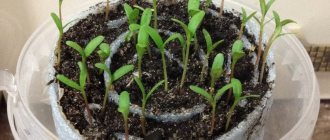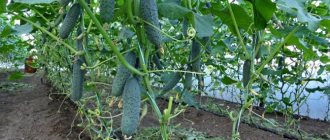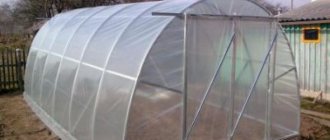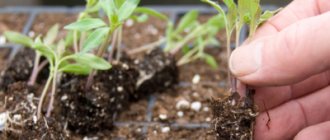Greetings. You know, the answer to the question: “How to grow tomatoes in a greenhouse?” , I have known since childhood. Grandfather and grandmother grew tomatoes both for themselves and for sale. We always had early tomatoes on the table, and this is all because they planted tomatoes in the greenhouse using seedlings.
And I would like to share with you the secrets of an early and rich harvest. Tell you how to properly grow seedlings and their subsequent planting in a greenhouse. I will share family secrets on caring for tomatoes and combating possible difficulties: pests and diseases. And following my recommendations you will grow an early harvest of tomatoes. I suggest studying and implementing.
Why do I grow tomatoes with seedlings in a greenhouse?
I turn to growing tomatoes in greenhouse conditions for a lot of reasons:
- Possibility of harvesting ultra-early and late harvests - from early spring to late autumn.
- Growing tall bushes that do not take root well in open ridges. It is these seedlings that produce large fruits up to 0.5 kg.
- The possibility of planting productive heat-loving varieties that do not do well in harsh Russian conditions.
Greenhouse plants do not require additional care - all activities are simple and familiar, even a beginner can do it.
tall tomatoes in a greenhouse
Basic principles for obtaining high yields
Tomatoes in a greenhouse
There are four main rules, the implementation of which allows you to annually collect a large number of aromatic tomatoes from the beds:
- choosing a variety that is suitable for a specific area
- planting healthy seedlings
- choosing a suitable growing site
- maintaining appropriate care
When to plant tomatoes in a greenhouse
I determine the readiness of tomatoes for moving by the following criteria:
- Height 20-25 cm.
- 8-12 developed true leaves.
- Formation of 1-2 inflorescences.
- Approximate age: 50-55 days.
I will also introduce you to the approximate dates.
Planting tomatoes by region
Planting seedlings in heated glass greenhouses:
- Northern regions: early May.
- Mid-latitudes: end of April.
- Southern regions: early to mid-April.
Moving to unheated greenhouses:
- Northern regions: second half of May.
- Middle latitudes: first ten days of May.
- Southern regions: end of April.
Planting in light film greenhouses:
- Northern regions: early June.
- Mid-latitudes: end of May.
- Southern regions: early to mid-May.
I advise you to focus on the characteristics of a particular year - cold summer, warm spring, sharp frosts, prolonged thaw, etc.
Planting tomatoes according to the lunar calendar
I will list the favorable dates according to the lunar cycles for 2021:
- in January 2022, you can plant tomatoes on seedlings 2, 14, 17, 18, 20;
- in February 2022, 6 - 9, 11, 12, 14;
- in March it is best to plant tomatoes 7 - 10, 15, 16
- In April, the best planting days for tomatoes are 6, 7, 11 - 12, 17, 18.
- May when to plant tomatoes: 2, 3, 8,9, 15 - 18.
The seedlings planted these days develop strong, healthy, and disease-resistant.
tomato seedlings
Review of favorite tomato varieties for planting in a greenhouse
Let me introduce the reliably proven varieties of greenhouse tomatoes:
- Major. Indeterminate high-yielding tomato. Fruits with dense pink pulp and a pleasant smell. The variety is resistant to both unfavorable conditions and diseases.
- Miracle of the earth. A high-yielding and early-ripening variety that is very popular among gardeners. The seedlings are tall, the fruits are heart-shaped, very sweet. Some tomatoes can reach a weight of up to 900 g. Plants are resistant to sudden temperature changes and drought.
- Gondola. Mid-season, indeterminate hybrid variety. The fruits weigh 150-500 g. The pulp is red and dense. Tomatoes have excellent keeping quality. They can be eaten fresh, salted, pickled, as part of side dishes and sauces.
- Kohawa. Ultra-early ripening and high-yielding variety. The tomatoes are flat round, weighing up to 150-180 g. The first fruits appear on the 90th day of the plant’s life. The seedlings are resistant to fungal diseases.
- Silhouette. High-yielding mid-early hybrid tomato. The fruits have an unusual rounded-flattened shape with excellent taste. The variety is resistant to unfavorable conditions.
- Dina. Mid-season productive variety. The seedlings are medium-sized, the fruits are round, large (150-200 g), very sweet, interesting bright orange color, rich in keratin. The variety is resistant to diseases and drought.
- Lelya. A recent discovery by breeders is an early ripening and high-yielding tomato. The fruits are small (up to 100 g) with bright red tasty pulp.
- Hurricane. An early-ripening, productive variety. The average weight of tomatoes is 80-90 g. Suitable for consumption fresh, pickled, or processed. The first harvest is harvested 85-90 days after planting.
- Long Keeper. Late high-yielding variety. The plant is of medium height, the fruits are large (up to 300 g), round. Tomatoes ripen well when stored.
- Bull's heart. A variety that has long won recognition among gardeners. Depending on the variety, it produces black, red and yellow fruits weighing up to 300 g, with juicy and fleshy pulp. The plant has record yields.
I never stop at one variety. I prefer to grow ultra-early, mid-ripening and late-ripening ones so that I have delicious tomatoes on my table all summer. When choosing a tomato variety, I focus on the following characteristics: yield, shelf life, ripening time, taste, bush size, approximate weight, fruit size.
tomato varieties
Watering tomato bushes
Watering tomato bushes
After planting, the first watering is carried out 10-14 days later. In June you can water once a week. From July, the amount of watering is increased to 2-3 times a week, depending on the weather.
You need to water the bushes at the roots in the evening. Morning and evening water procedures can harm the plant.
How to grow tomato seedlings correctly
A rich harvest begins with proper seedling preparation. I take care of future plantings by purchasing seeds and breeding seedlings.
Preparing seeds for sowing tomatoes
I approximately sow seeds for seedlings from the beginning of February to the last days of March. The timing varies depending on the type of culture:
- Early. End of March.
- Mid-season. Continuing March.
- Late. End of February.
If you do not want to spend time preparing seed, I recommend purchasing coated seeds that have already been processed by the manufacturer. They are planted in the ground immediately, dry. The rest of the seeds require simple preparation:
- Disinfection in Fitosporin solution for 15 minutes.
- Soak for 15 minutes in a growth stimulator solution. I use sodium humate: ¼ teaspoon per 1 liter of water.
After such simple preparation, the seeds are ready for sowing.
treatment of tomato seeds with Fitosporin-M
Preparing the soil for seedlings
Tomato seedlings do not require special soil - any fertile and loose soil will do. I buy humus and turf soil treated from viruses, fungi and pests at the garden center. You can pay attention to special soil mixtures for nightshades and tomatoes. “Living Earth” and “Tomato and Pepper” soil are popular.
Planting seeds for seedlings is simple:
- Make holes in the bottom of each container to drain excess water and allow air to reach the roots.
- Pour the soil mixture into the prepared cups.
- Make shallow (1-1.5 cm) grooves. If you have prepared the boxes, maintain a distance of 5-7 cm between them with the indentations.
- Spill the soil with heated water.
- Place the seeds in the depressions, cover with soil, and compact the substrate a little with your hands.
- Cover with glass or wrap with cling film.
- Place containers on pallets.
Now you need to move the boxes and glasses to a well-lit, warm place and wait for the first shoots.
Caring for tomato seedlings
The first seedlings appear after 7 days. By the 5th week of development, the gardener makes sure that the plants do not stretch out - this is the time of their increased growth. The seedlings are kept in a well-lit place, the pots are turned 180 degrees every day so that the seedlings do not reach for the light.
The temperature regime is maintained as follows:
- First week. During the day – 16-18 C, at night – 13-15 C.
- Before the dive. During the day – 18-20 C, at night – 15-16 C.
- After the pick. During the day – 20-22 C, at night – 16-18 C.
- Before moving to the greenhouses. During the day – 18-20 C, at night – 15-16 C.
With watering, things are as follows:
- The first watering is when sprouts appear.
- The second – after 7-14 days.
- The third is before the pick.
- After picking - weekly watering.
Use water heated to room temperature, and water the plants at the roots.
After picking, additional feeding is needed:
- A week later. 1 tbsp. spoon of nitrophoska per 10 liters of water. Consumption: 1/2 cup of suspension per 1 bush.
- In 14 days. For 10 liters of water – 1 tbsp. spoon of the drug “Signor Tomato”, 1 tbsp. spoon of superphosphate. Consumption: 1 glass of solution per 1 plant.
- In 2 weeks. For a bucket of water - 1 tbsp. spoon of nitrophoska. For 1 bush – 1 glass of solution.
Fertilizing is carried out after watering. If the soil settles, add more substrate.
Picking tomatoes
If you are propagating seedlings in common boxes, when 2-3 leaves appear, the seedlings are given a pick:
- Take pots with a height and diameter of 8 cm, fill them with the same seedling soil mixture.
- Spill the soil with manganese solution (0.5 g per 1 liter of water).
- Transplant only the strongest and most robust seedlings.
When picking, you can bury seedlings that are too elongated up to the cotyledon leaves.
picking tomatoes
How to pick tomato seedlings: video
How to prepare tomato seedlings for planting in the ground
Already in April - May it is worth starting hardening:
- Open windows in rooms where plants are located. Start with several hours, gradually increasing the ventilation time. At the same time, avoid drafts.
- As soon as the weather gets warm outside, move the plants to the balcony. Start with a 2-hour “walk” and gradually increase the time.
Hardened seedlings acquire a characteristic greenish-purple hue. It should be sent for “walks” pre-watered.
The last preparatory step is pinching 2-3 lower leaf plates. In their place, short “stumps” (2-3 cm) are left. This promotes improved air circulation and good lighting of the plantings.
Preparing a greenhouse for planting tomatoes
Before moving tomatoes, you need to properly prepare the greenhouse. I will introduce you to the techniques that I use personally.
How to prepare the soil for planting tomatoes
Traditionally, I replace greenhouse soil once every five years. During this time, it manages to be completely depleted, even if you regularly applied fertilizers.
First thing in the fall, I disinfect the greenhouse substrate using improvised means:
- A solution (1%) of Bordeaux mixture.
- Suspension (1%) of copper sulfate.
- Dolomite flour (50 g per 1 m2).
Then I proceed to the actual preparation of the land:
- I arrange the lower insulating layer - first a 10-centimeter layer of sawdust, dry pine needles or straw. On top is another 10-centimeter layer of rotted compost.
- I fill the insulating bedding with garden soil - it turns out to be a raised ridge 30-40 cm high.
- If the ground is turf, fertilizers are applied during digging (per 1 m2): 3 tbsp. spoons of superphosphate in granules, 1 tbsp. spoon of potassium magnesia, 1 tbsp. spoon of potassium sulfate, 2 tbsp. spoons of ash, 1 teaspoon of urea (replacement - sodium nitrate).
- If the soil is clayey or loamy, an additional bucket (per 1 m2) of peat, humus and crushed sawdust is required.
- If the substrate is peat, additionally add (per 1 m2) 1 bucket of turf, humus, wood shavings or sawdust, and ½ bucket of coarse sand.
After such preparation, the greenhouse is completely ready for the spring transfer of seedlings.
Temperature
Tomatoes can be transplanted into a greenhouse when the temperature is set:
- Priming. Not lower than 13 C at a 10-centimeter depth.
- Air. 20-25 C.
If your greenhouse is heated, these conditions can be created artificially at any time - plant seedlings in early spring and eat fresh tomatoes until late autumn.
Pollination
The tomato is a self-pollinating plant that produces a lot of high-quality pollen. But if you want to reap large harvests, then the crop should be helped by attracting helper insects (bees and bumblebees).
Pollination process
To do this, you just need to sow bright annual honey plants between the tomato bushes: mustard, rapeseed, coriander or basil. These crops will not only attract bees to the garden beds, but also improve the taste of the fruit and loosen the soil.
Sometimes a tomato fails to self-pollinate. The reasons for this may be:
- the night temperature dropped sharply and is no higher than +13 degrees (as a result, the anther was deformed)
- daytime temperatures stay at +30-35 degrees and above for a long time (in such conditions, flowers wither and pollen grains die)
- unfavorable pistil structure in some large-fruited varieties
Artificial pollination of tomatoes
In such cases, it is necessary to help the plant to pollinate. You can lightly tap the flowering brush or tilt the bud with the protruding pistil and shake it. The ideal time for artificial pollination is considered to be from 10 a.m. to 2 p.m. It is recommended to repeat the procedure after four days. Immediately after pollination, the plant must be watered or sprayed.
How to plant tomato seedlings in a greenhouse step by step
I will present popular schemes for planting tomato seedlings:
- Low-growing and early-ripening, developing into 2-3 stems. Checkerboard arrangement: between rows - 50-55 cm, between plants in one line - 35-40 cm.
- Determinate, standard. Between rows - 40-45 cm, between bushes of the same row - 20 cm.
- Gigantic. They are planted staggered according to the following pattern: between rows - 75-80 cm, between tomatoes of the same row - 55-60 cm.
I plan the transplant itself on a cool, cloudy day. I will present simple step-by-step instructions:
- I make holes 40 cm deep.
- I pour a warm (50-60 C) suspension of potassium permanganate. For 10 liters of water - 1 g of potassium permanganate. One well requires 1-1.5 liters of solution. An alternative is disinfection with Zaslon. You need 250 g of product per 10 liters of water. Consumption per well is 0.5 liters of solution.
- I plant the seedlings with a ball of earth directly into the soil, liquefied by irrigation. If tomatoes were grown in peat cups, I do not remove them.
- I plant low-growing plants straight, overgrown plants at a slight angle.
- I place the tomatoes with already formed inflorescences towards the greenhouse aisle so that they are not shaded by their neighbors.
- I cover each seedling with loose soil and compact it with my palms.
- Finally, you need to add mulch - last year's compost, straw, sawdust, mowed and dried grass.
Some gardeners leave a small hole near each tomato - this is convenient for economical root feeding.
Reviews from gardeners
Olga, Dnepropetrovsk
This greenhouse retains heat better than a greenhouse under glass, better than under two films. Polycarbonate is transparent, harmless, durable, and hail will not break through it like film.
Source: otzovik.com
Yuri, Grodno
I grow only tall, indeterminate varieties. Otherwise, why would they make a greenhouse 2.5 meters high? I don’t use any chemicals, out of principle. The entire land of the greenhouse. I cover it with straw and hay.
Source: forum.grodno.net
Caring for tomatoes after planting
After transplanting, I don’t touch the tomatoes for 5-6 days - I give them time to adapt to unusual conditions. After a week, I carefully loosen the soil around each bush to improve air access to the roots. Then you can begin periodic care.
How to properly water tomatoes in a greenhouse
I want to talk in detail about the features of watering tomatoes:
- This crop requires relatively moderate but frequent watering.
- After each watering, loosening and ventilation are required.
- For water procedures, use water heated under the sun. Pour it into buckets, barrels in the morning, and use it already warm for evening watering.
- It is best to water the plants manually using a hose (at low pressure) or a watering can.
- Tomatoes are watered only at the root. Even the smallest drops of water falling on the leaves can cause sunburn.
Let me present a schedule of water treatments:
- After transplantation, do not water the seedlings for 7-10 days. Otherwise, the development of the root system will be inhibited, and the green part will stretch out.
- Before the fruit starts to set, plants need frequent and abundant watering - once every 5-6 days. One bush needs at least 4-5 liters of water in one sitting. The soil should be well moistened to a depth of 15-20 cm.
- When the first tomatoes appear, watering is increased to once every 3-4 days. However, water consumption is reduced - 3-4 liters per bush is enough.
The fact that the plant is suffering from thirst can be easily understood by the curled upper leaves. And if there is an excess of moisture, even young tomatoes begin to burst.
How to fertilize tomatoes in a greenhouse
Greenhouse tomatoes need 3-4 feedings during the summer season. I traditionally follow this schedule:
- 3 weeks after transplant. For 10 liters of water – 1 tbsp. a spoonful of nitrophoska, 0.5 liters of liquid cow manure. For each bush - 1 liter of solution.
- After 10 days. For 10 liters of water – 1 tbsp. spoon of superphosphate, 1 teaspoon of potassium sulfate. Approximate consumption: ½ bucket of suspension – per 1 m2.
- In 2 weeks. For 10 liters of water - 2 tbsp. spoons of ash, 1 tbsp. spoon of superphosphate. Consumption – 6-8 liters of fertilizer per 1 m2.
- When tomatoes begin to ripen. For 10 liters of water - 2 tbsp. spoons of superphosphate, 1 tbsp. spoon of potassium humate. Approximate consumption is ½ bucket of mixture per 1 m2.
Such complex fertilizing is sufficient for the harmonious development of the plant.
fertilizer for feeding tomatoes
How to grow tomatoes in a greenhouse
As a rule, I carry out the first stepsoning before the seedlings are moved or in the first days after transplantation. I always leave a 2-3 cm “stump” in place of each stepson. This is necessary so that a new process does not begin to develop in its place.
I will present to you the most important rules for growing greenhouse tomatoes:
- Pinch the shoots with your nails and disinfect your hands after each contact with plants to avoid becoming a carrier of infections.
- Plan the procedure in the morning - at this time the stems break off more easily.
- The frequency of stepsoning is 1 time per week.
- After the tomatoes are filled, do not forget to pluck all the lower branches. This is necessary to improve air circulation and prevent fruit rotting.
If you have few seedlings, do not throw away the shoots. Dip their torn ends into water - after a few days the strongest specimens will take root. They can also be planted in a greenhouse and wait for a small harvest.
Ventilation of tomatoes
Gardeners who plant tomatoes in a greenhouse sometimes forget about an important matter - ventilation. The procedure is needed after each watering of the plant. Tomatoes do not tolerate high air humidity. In such unfavorable conditions, the risk of late blight and other fungal infections increases.
I stick to the following temperature regime:
- Initial period of development: day – 20-25 C, night – 16-18 C.
- Formation, ripening of fruits: day – 24-25 C, night – 17-18 C.
The air humidity level should remain stably within 60-65%. Ventilation is especially important when tomatoes are flowering. If condensation forms, the tomatoes will grow tasteless, sour and watery.
How to tie up tomatoes in a greenhouse
When planting seedlings, do not forget to install supports - trellises or pegs - next to each bush. If there are few plants, the latter will be more convenient - use wooden slats, iron rods, and scraps of thin plastic pipes. The peg should be 20-25 cm higher than the plant. For stability, it is driven into the ground at approximately the same distance. The support is installed near the stem, gartering is carried out as necessary.
If you grow tall tomatoes, it is best to install permanent trellises. This will also save space in the greenhouse: it will be possible to plant 3-4 plants per 1 m2. Strong stakes up to 2 m high are driven in between rows. Wire or strong rope is pulled between them every 35-40 cm. Growing tomatoes are passed between the supports, forming a kind of “braid”.
garter pins
Fertilizing with mineral and organic fertilizers
Tomatoes receive nutrients both from the soil and with the help of root and foliar fertilizers; they are necessary for:
- for growth;
- bush development;
- flowering;
- fruit set;
- subsequently for maturation.
When preparing the soil for planting, we initially apply mineral fertilizers to fill them with nutrients before digging, scattering them on the surface of the earth.
Tomato bushes begin to be fed 2-3 weeks after planting in the ground and continue until mid-August.
What difficulties may arise when growing tomatoes in a greenhouse?
Greenhouse tomatoes are sometimes overcome by illnesses and enemies. But both pests and diseases can be successfully resisted using preventive, “therapeutic” methods.
Pest control on tomatoes
Let me introduce you to the most harmful enemies of greenhouse tomatoes:
- Wireworms. To prevent the spread of pests, about a week before moving the tomatoes, build simple traps: make holes around the perimeter, into which you place and bury a “kebab” on a stick - pieces of raw vegetables. After a few days, check the bait and destroy the pests. Wireworms can be found and collected manually by deep digging of the soil. Prevention of pest occurrence - liming, application of mineral fertilizers. When the disease is prevalent, use the insecticide “Bazudin” - according to the instructions, mix the powder with the soil.
- Medvedka. Pest eggs can enter the greenhouse when the soil is replaced. At the initial stages, it can be effectively resisted with folk remedies: infusion of red pepper (150 g per 10 liters of water), vinegar water (2-3 tablespoons per 10 liters) - approximately 0.5 liters of liquid are poured into the pest's burrows. If the problem is serious, turn to insecticides - “Thunder”, “Medvetox”, “Grizzly”.
- Whitefly. Before the tomatoes begin to bloom, the butterfly is effectively combated with Sochva liquid smoke. If the whitefly has completely flooded the greenhouse, spray with a “Phosbecid” suspension - 10 ml per 10 liters of water. Treatment is done before or after sunset. To consolidate the result, spraying is repeated twice more with a break of 15-20 days.
- Caterpillars and cutworm butterflies. Traps - jars of fermenting kvass - are effective against flying specimens. The drink is diluted with water (1:3), a little yeast is added. The caterpillars are collected by hand, and the tomatoes are treated against them with an infusion of wormwood or potato tops. Of the special preparations, “Fitoverm” and “Agravertin” are effective.
I advise you to periodically inspect your plantings for pests. It is easier to destroy them in the initial stages with folk remedies than to use harmful insecticides.
fighting whiteflies in the garden
scoop butterfly
fighting mole crickets in the garden
Prevention of tomato diseases in the greenhouse
Let me introduce the common diseases of greenhouse tomatoes:
- Fomoz (brown rot). Diseases are countered by disinfecting the substrate before planting and avoiding fresh manure and nitrogen fertilizers. Infected stems and fruits are promptly picked off and destroyed. Plants are treated with “Barrier” or “Fundazol”.
- Gray rot. Prevention of the problem is to adhere to the watering schedule. If the disease has made itself felt, the tomatoes are fed with calcium nitrate - 40-50 g per 5 liters of water. You can add phosphorus-potassium fertilizer or a folk remedy - ash solution (250 g of ash per 10 liters of water).
- Apex rot. Prevention of disease - compliance with the correct temperature regime, watering schedule, timely application of calcium supplements.
- Fusarium. You can prevent the disease by carefully handling the seedlings (the disease develops when the roots are damaged), watering with preheated water, and warming up the greenhouse soil before moving the seedlings.
- Mosaic. It is better to dig up and destroy diseased bushes - if they are infected with the virus, they will no longer be productive. Disease prevention is to disinfect seeds before sowing in a 1% manganese solution. They also disinfect seedlings as they grow - 2-3 times with a break of 3 weeks. 1 g of potassium permanganate is diluted in 10 liters of water and used for irrigation.
rot on tomatoes in a greenhouse
Now you know inside and out how to grow healthy and productive tomatoes in a greenhouse. The very first important stage is propagation of seedlings. Don’t forget about preparing the greenhouse for moving seedlings and preventing diseases and pests. Remember that royal harvests are produced only by plants that are well cared for - watered on time and efficiently, fed, tied up and planted.











